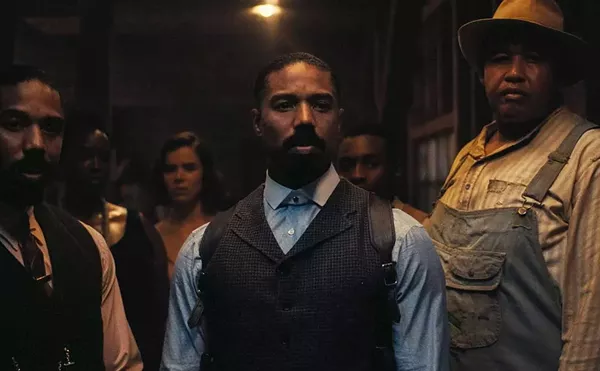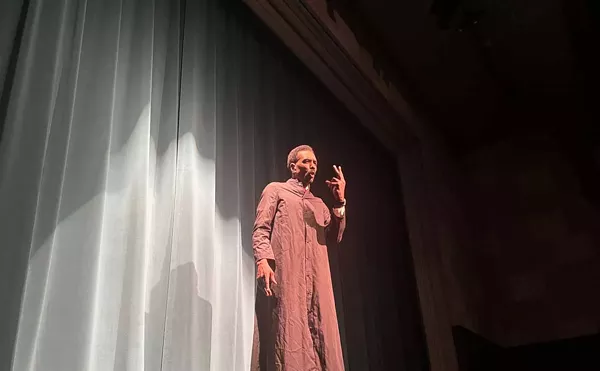
Audio By Carbonatix
[
{
"name": "GPT - Leaderboard - Inline - Content",
"component": "35519556",
"insertPoint": "5th",
"startingPoint": "3",
"requiredCountToDisplay": "3",
"maxInsertions": 100,
"adList": [
{
"adPreset": "LeaderboardInline"
}
]
}
]
The Catonsville Nine: A Story of Faith and Resistance in the Vietnam Era
by Shawn Peters
Oxford University Press, $34.95, 416 pp., hardcover
Born in Catonsville, Md., 18 months before what has been called "the single most powerful anti-war act in American history," Shawn Peters has spent most of his life working on The Catonsville Nine: A Story of Faith and Resistance in the Vietnam Era.
On May 17, 1968, nine people, including two Catholic priests and a former nun, entered Local Draft Board No. 33 in the Baltimore suburb and removed 378 draft files, dragged them outside in large, wire trash-burners and doused them with homemade napalm. Setting them ablaze, they waited to be arrested. Federal and state trials followed. The Nine were found guilty and sentenced to two to six years in prison.
The Catonsville Nine were front-page news. The story shocked and captivated the nation, but to fully appreciate its impact today, you have to consider that, 40 years ago, people held church officials in a much higher regard. Priests and nuns were still moral authority figures then. Seeing them willfully break the law, risking arrest and imprisonment, forced many to pay attention. Regardless of whether or not you agreed with their approach, the Nine made people stop and question the Vietnam War — maybe not all at once, but they planted a seed.
The Nine were the Revs. Daniel and Philip Berrigan, Brother David Darst, John Hogan, Tom Lewis, Marjorie and Thomas Melville, George Mische and Mary Moylan. Not your typical anti-war protesters, they ranged in age from 26 to 47. Their backgrounds were varied. Most came from working-class families and participated in the civil rights movement. Four had worked abroad as missionaries, and collectively, they drew on experiences in Guatemala, the Dominican Republic, Uganda, and the inner-city ghettos of America. The story of how these nine individuals came together and what happened after the Catonsville incident has been obscured by time, myth, and conflation.
Previously published books about the Nine fall into two categories: Berrigan biographies or works of social justice or religious studies. Drawing on a wealth of sources, including newly obtained FBI documents, news accounts, oral histories, books written by his subjects and documentary films (including, for full disclosure, one by this reviewer), Peters — a University of Wisconsin-Madison faculty member whose previous works include When Prayer Fails, Judging Jehovah's Witnesses and The Yoder Case — offers up a compelling hybrid, a masterful work of history and group biography.
The Berrigans remain an important part of the story, but not the only part. Philip was an outspoken anti-war priest serving a black congregation in Baltimore's Druid Heights neighborhood, and a regular in the local and national press. Older brother Daniel, also a priest, was a famous poet. The image of these two charismatic brother-priests being led off to prison on moral grounds is so powerful that the other seven members of the group have received only a few perfunctory paragraphs.
When we frame the Nine as the story of two famous priests leading seven followers, history gets lost. Take, for instance, the fact that three of the Nine had served in the military. Philip had fought in the Battle of the Bulge during World War II, earning three bronze stars. George Mische and Tom Lewis had each served eight years and received honorable discharges from the Army and National Guard, respectively. These weren't simply clerics or peaceniks against the war in Vietnam. They were veterans against the war.
The Melvilles (and John Hogan) had been Maryknoll missionaries in Guatemala just a year before Catonsville. They saw U.S. policy at odds with their mission to help the poor. Thwarted in many of their efforts to help, they also came to see the Roman Catholic church and Guatemalan government as more interested in maintaining the status quo than improving the lives of Mayan farmers and peasants. In 1967, the three Maryknollers were forced to leave Guatemala when word spread to their superiors that they'd been having meetings with students and leftist guerrillas. This experience formed the basis for their participation in Catonsville.
Mary Moylan spent time as a nurse in Uganda. After Catonsville, she decided to go underground rather than report for prison. She remained a fugitive for nine years before turning herself in. In that time Moylan settled in with the "women's brigade of the Weather Underground Organization." Though her level of commitment to the group, whose actions included planting a bomb at Harvard, remains uncertain, Peters shows how she became committed to the women's movement and even more radical after Catonsville.
By treating each of the Nine equally, Peters makes the message of their action — that anyone could do what they did — more clear. These were not pious martyrs. They were average people doing what they thought was right. During their October '68 trial, they explained why they broke the law, arguing that all citizens have a moral responsibility to stand against destructive violence carried out in their names. And though the jury didn't buy it, dozens of like-minded activists across the country heard them and began staging their own raids.
Catonsville Nine helps us understand and re-evaluate the social justice movements of our recent past. It expands the traditional view of this important anti-war action, favoring heroic acts and ideas over heroes. Considering the current levels of polarization and political helplessness—a decade of endless wars in Iraq and Afghanistan, new civil rights issues like racial profiling and marriage equality, and politicians who seem to have no real solutions — this book couldn't come at a better time.
John Tropea writes for City Paper in Baltimore, where this first appeared. Send comments to letters@metrotimes.com.





